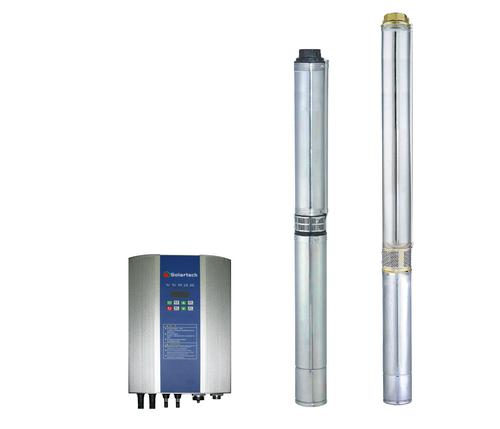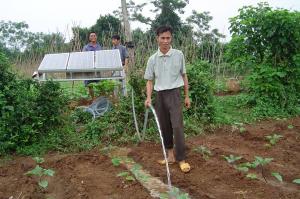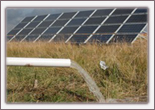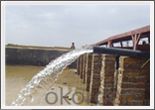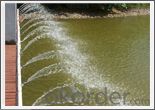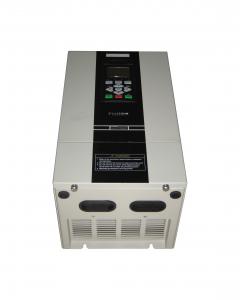Solar Pump Suppliers - Water for Life Solar Pumping Systems
- Loading Port:
- Shekou
- Payment Terms:
- TT OR LC
- Min Order Qty:
- 20 unit
- Supply Capability:
- 800000 unit/month
OKorder Service Pledge
OKorder Financial Service
You Might Also Like
Solar Inverter Introduction:
Solar pumping inverter converts DC current from the solar array into AC current to drive the pump. With the function of MPPT (maximum power point tracking), it regulates the output frequency according to irradiation in real time to achieve the maximum power.
Solar Inverters Features:
1. Adopting the proposed dynamic VI maximum power point tracking (MPPT) control method; Fast response and stable operation; Better than the conventional methods which may lead to the problems including poor tracking performances, unstable or even cause water hammer damaging when the irradiation on the array changes rapidly.
2. The solar pumping inverters system is dispensed with energy storing devices, and stores water instead of electricity. It improves the reliability of the device, at the same time, it lowers the construction and maintenance costs of the system dramatically.
3. Digital control; automatic operation and data acquisition/storage of 8 years, etc; 98% of conversion efficiency, and complete protection.
4. In-line blocks; user friendly; convenient for operating; perfect cooling and shielding.
Solar Pumping Inverter Advantages:
1. To drive pumps equipped with 3-phase induction motors.
2. Optimized SPWM.
3. Various operation modes and MPPT algorithms are available.
4. Adjustable speed range of pump based on the actual situation of the system.
5. Available option of water-level detecting and control circuit.
6. Protection functions: lightning, over/low input voltage, over current and over load protection, etc.
7. Enclosure class: IP52.
8. Ambient temperature:-10~+50˚C.
Specification:
Model | Maximum input dc voltage | Recommended MPP Voltage | Rated Output Current | Output Voltage | Output Frequency | Net Weight | Gross Weight | Package Size | ||
Length | Width | Height | ||||||||
PB5500H | 750 | 500-600 | 13 | 3PH 380V | 0-50 | 7.3 | 9.6 | 425 | 325 | 285 |
PB7500H | 750 | 500-600 | 18 | 3PH 380V | 0-50 | 7.7 | 10 | 425 | 325 | 285 |
PB11KH | 750 | 500-600 | 24 | 3PH 380V | 0-50 | 8.2 | 10.5 | 425 | 325 | 285 |
PB15KH | 750 | 500-600 | 30 | 3PH 380V | 0-50 | 8.4 | 10.7 | 425 | 325 | 285 |
PB18KH | 750 | 500-600 | 39 | 3PH 380V | 0-50 | 8.4 | 10.7 | 425 | 325 | 285 |
PB22KH | 750 | 500-600 | 45 | 3PH 380V | 0-50 | 18 | 21 | 600 | 465 | 350 |
PB30KH | 750 | 500-600 | 60 | 3PH 380V | 0-50 | 18 | 21 | 600 | 465 | 350 |
PB37KH | 750 | 500-600 | 75 | 3PH 380V | 0-50 | 20 | 23 | 600 | 465 | 350 |
PB45KH | 750 | 500-600 | 91 | 3PH 380V | 0-50 | 20 | 23 | 600 | 465 | 350 |
PB55KH | 750 | 500-600 | 112 | 3PH 380V | 0-50 | 20 | 23 | 600 | 465 | 350 |
►Middle East ►NaQu ►GuiLin
►Turkey ►XiNing ►YunNan
►Army stationed island ►Bangladesh ►Pakistan
►HaiNan ►HuBei ►Uganda
►XinJiang ►NingXia ►Afghan
►Zimbabwe ►Inner Mongolia ►Zhejiang
►Guangxi Guilin ►Turkey2 ►Botswana
►Naning ►Uganda ►Shaanxi
►Tsinghua University ►Pakistan ►Yunnan2
►FuJian ►Banqladesh ►YunNan3
►Turkey ►Inner Mongolia ►Senegal
- Q: Can solar pumps be used for water supply in remote fishing villages or coastal communities?
- Yes, solar pumps can indeed be used for water supply in remote fishing villages or coastal communities. Solar pumps are a reliable and sustainable solution, as they use solar energy to power the pump and provide water for various purposes such as drinking, fishing, and irrigation. This eliminates the need for costly and unreliable traditional fuel-based pumps, making it a cost-effective and environmentally friendly option for these communities. Additionally, solar pumps can be easily installed and require minimal maintenance, making them suitable for remote locations where access to electricity may be limited.
- Q: How does a solar pump handle water with high levels of pesticides or herbicides?
- A solar pump does not have any specific mechanism to handle water with high levels of pesticides or herbicides. However, it can still pump water containing these substances. The efficiency of removing or diluting the pesticides or herbicides would depend on the specific filtration system, if any, attached to the solar pump. To effectively handle water with high levels of pesticides or herbicides, additional treatment methods such as activated carbon filters or advanced oxidation processes may be required.
- Q: How does a solar pump help in reducing the use of chemical fertilizers?
- A solar pump helps in reducing the use of chemical fertilizers by providing a sustainable and renewable source of energy for irrigation. By using solar power, farmers can irrigate their crops without relying on conventional pumps that are usually powered by fossil fuels. This not only reduces the carbon footprint but also eliminates the need for transporting and storing chemical fertilizers, as the solar pump ensures a consistent water supply for the crops. Consequently, the reliance on chemical fertilizers is decreased, promoting more environmentally friendly and organic farming practices.
- Q: How much energy does a solar pump consume?
- A solar pump consumes very minimal energy as it relies on solar panels to generate power from sunlight, making it an energy-efficient and environmentally friendly option.
- Q: What is the payback period for a solar pump system?
- The payback period for a solar pump system varies depending on factors such as the initial cost of the system, the savings generated from reduced energy bills or water costs, and any potential government incentives or grants. On average, it can range from 2 to 7 years.
- Q: How does a solar pump handle sediment in the water?
- A solar pump typically handles sediment in the water by utilizing a filtration system. The pump is designed with filters that prevent sediment and larger particles from entering the system, ensuring a cleaner flow of water. Additionally, regular maintenance and cleaning of these filters is required to maintain the pump's efficiency and prevent clogging.
- Q: What is the expected lifespan of the controller in a solar pump?
- The expected lifespan of a controller in a solar pump can vary depending on several factors such as the quality of the controller, usage patterns, maintenance practices, and environmental conditions. However, on average, a well-maintained and high-quality solar pump controller can be expected to last for around 10 to 15 years.
- Q: Can a solar pump be used in areas with limited access to water conservation?
- Yes, a solar pump can be used in areas with limited access to water conservation. Solar pumps are an efficient and sustainable way to extract and distribute water, especially in areas where traditional electricity supply is unreliable or unavailable. By harnessing the power of the sun, these pumps can be utilized to draw water from various sources, such as wells or rivers, and help conserve water by efficiently delivering it to areas in need.
- Q: What is the expected efficiency loss over time for a solar pump?
- The expected efficiency loss over time for a solar pump can vary depending on various factors such as maintenance, system design, and environmental conditions. However, with proper care and regular maintenance, solar pumps are generally known for their long-term efficiency and durability. It is common for solar pumps to maintain a high level of efficiency for many years, resulting in minimal efficiency loss over time.
- Q: Can a solar pump be used for water supply in community gardens or urban farming projects?
- Yes, a solar pump can be used for water supply in community gardens or urban farming projects. Solar pumps are a sustainable and environmentally friendly solution as they utilize the energy from the sun to pump water. They are ideal for remote locations with limited access to electricity and can efficiently provide water for irrigation and other agricultural needs. Additionally, solar pumps require minimal maintenance and operating costs, making them a practical choice for community gardens and urban farming projects.
Send your message to us
Solar Pump Suppliers - Water for Life Solar Pumping Systems
- Loading Port:
- Shekou
- Payment Terms:
- TT OR LC
- Min Order Qty:
- 20 unit
- Supply Capability:
- 800000 unit/month
OKorder Service Pledge
OKorder Financial Service
Similar products
Hot products
Hot Searches
Related keywords






